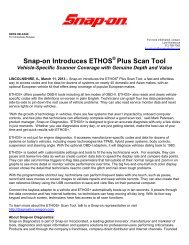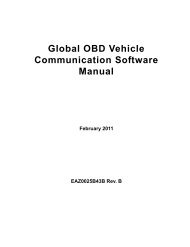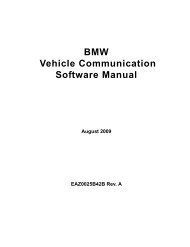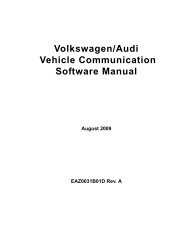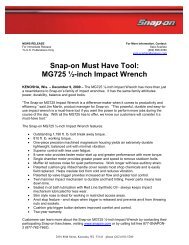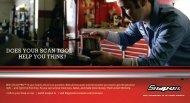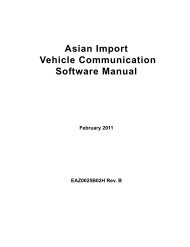MICROSCAN User Manual - Snap-on
MICROSCAN User Manual - Snap-on
MICROSCAN User Manual - Snap-on
You also want an ePaper? Increase the reach of your titles
YUMPU automatically turns print PDFs into web optimized ePapers that Google loves.
Chapter 4 On-Board Diagnostics (OBD)<br />
Your new <str<strong>on</strong>g>MICROSCAN</str<strong>on</strong>g> c<strong>on</strong>forms to Global OBD (OBD-II in North America and EOBD in Europe)<br />
standards, and is designed for testing compliant vehicles. This chapter describes Global OBD.<br />
4.1 Global OBD and What it Means<br />
Many countries have enacted strict emissi<strong>on</strong> related regulati<strong>on</strong>s that will drive increased<br />
technology into the modern automobile in order to reduce the exhaust emissi<strong>on</strong>s. European and<br />
North American countries lead the way by adopting technology that standardizes the way these<br />
vehicles can be checked for compliance.<br />
The OBD-I (On-Board Diagnostics I) system was introduced in the early 1980s and by 1988 all<br />
new cars and light trucks sold in California had to have OBD-I. The fundamental elements of the<br />
OBD-I are the electrical comp<strong>on</strong>ents (which influence exhaust emissi<strong>on</strong>s) that are m<strong>on</strong>itored by<br />
the engine management system. An optical warning signal is given in the event of an OBD-I<br />
relevant failure. This fault can be read out by way of a flashing code.<br />
OBD-II has been compulsory <strong>on</strong> all vehicles in the US market since January 1996. EOBD<br />
(European On-Board Diagnostics) is the European equivalent to OBD-II. It was introduced in 2000<br />
and became effective in January 2001. There are a few differences between EOBD and OBD-II<br />
but n<strong>on</strong>e that will affect scan tool operati<strong>on</strong>. All the communicati<strong>on</strong> protocols for both programs are<br />
identical. Vehicle emissi<strong>on</strong> strategies and certificati<strong>on</strong> procedures vary between countries, states<br />
and regi<strong>on</strong>s. Always use service informati<strong>on</strong> specific to the country and emissi<strong>on</strong> certificati<strong>on</strong>.<br />
EURO-3, also known as EOBD, is a c<strong>on</strong>tinuati<strong>on</strong> of the emissi<strong>on</strong> regulati<strong>on</strong>s known as EURO-1<br />
and EURO-2. In additi<strong>on</strong> to introducing stricter emissi<strong>on</strong> limits, the directive now also covers the<br />
m<strong>on</strong>itoring of emissi<strong>on</strong> related comp<strong>on</strong>ents and functi<strong>on</strong>s during operati<strong>on</strong>.<br />
The OBD-II and EOBD system must show the failure of an emissi<strong>on</strong> related comp<strong>on</strong>ent or system<br />
to the driver using a MIL (Malfuncti<strong>on</strong> Indicator).<br />
What does OBD-II and EOBD mean for the Repair Shop?<br />
A universal c<strong>on</strong>nector can now be used <strong>on</strong> any OBD-II 1996 and newer and EOBD 2001 and<br />
newer vehicle, giving the shop more diagnostic coverage that was not previously possible.<br />
4.1.1 OBD-II Start-up Phase<br />
About 40% of the vehicles of model year 1995 sold in the USA were OBD-II prepared. Beginning<br />
in 1996, all vehicles sold in the USA were supposed to comply with OBD-II standards.<br />
However, some 1996 and 1997 vehicles were not fully OBD-II compliant. This means that some<br />
early OBD-II vehicles may:<br />
• Not have the standardized diagnostic c<strong>on</strong>nector locati<strong>on</strong> or<br />
• Have missing or <strong>on</strong>ly partially implemented OBD-II m<strong>on</strong>itors.<br />
12




